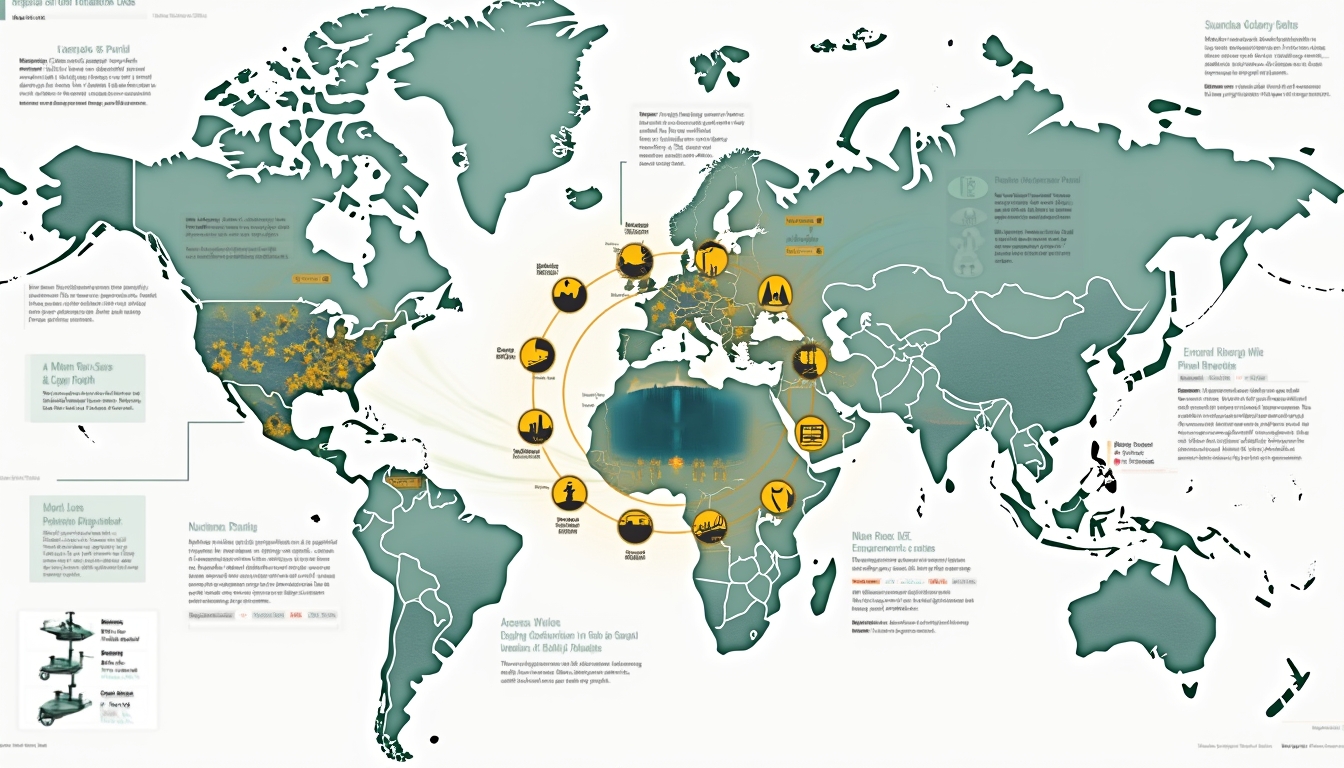What Is a Drilling Plan? Understanding the Strategic Blueprint for Drilling Success
A drilling plan is a comprehensive document that serves as a strategic roadmap for oil and gas exploration projects. It covers equipment selection, personnel requirements, safety protocols, and regulatory compliance measures. This detailed blueprint becomes the foundation for successful operations and helps implement Introduction to Drilling Plan Key Strategies effectively.
For further clarity on interpreting drilling results, consider this beginner’s guide to understanding mining drilling results.
A well-developed drilling plan is critical in high-stakes environments. Structured plans increase the likelihood of meeting deadlines and staying within budget by as much as 35%. Clear guidelines in the plan eliminate ambiguity and ensure consistent decision-making across every operational level.
Each plan is crafted after a detailed site analysis, specifying equipment, safety measures and risk assessments. This process transforms abstract ideas into actionable steps, ensuring projects follow Introduction to Drilling Plan Key Strategies.
The integration of precise methods with robust risk management leads to enhanced operational success.
Why Is a Drilling Plan Critical for Project Success?
Risk mitigation is a major reason for a comprehensive drilling plan. Drilling operations are inherently hazardous, requiring preparation to identify dangers early. Systematic risk assessments help teams implement preventative measures rather than react to issues as they occur.
Resource optimisation also plays a crucial role. Materials, personnel, and equipment are allocated efficiently in a detailed plan. This effective resource management cuts waste and boosts productivity.
Clear instructions foster scheduling accuracy, minimising non-productive downtime and streamlining the entire process. Regulatory requirements are easier managed too, particularly for agencies like the Bureau of Land Management.
A well-prepared plan ensures teams remain on track using Introduction to Drilling Plan Key Strategies and best practices. By addressing potential delays and safety risks upfront, drilling operations benefit from reduced stress and improved outcomes.
How to Create a Comprehensive Drilling Completion Plan
Step 1: Define Clear Project Objectives
Setting clear, measurable objectives is crucial. Teams must align technical needs, financial constraints, and environmental considerations from the start.
- Objectives should be specific, measurable, achievable, relevant, and time-bound.
- Clearly defined goals prevent conflicting priorities.
These objectives lay the groundwork for planning and ensure Introduction to Drilling Plan Key Strategies are followed throughout the project.
Step 2: Select the Appropriate Completion Type
Choosing the completion type shapes the entire operation. Options vary from open-hole completions to complex cased-hole systems.
The decision considers reservoir characteristics, production needs, and long-term well management. Balancing immediate output with long-term recovery is essential.
This choice is a critical juncture ensuring operations use the most appropriate methods. It is worth exploring diverse approaches, such as those outlined in understanding the jorc code for informed mining investments.
Step 3: Design Completion Components
Designing each component requires attention to detail. Engineers plan casing, tubing, and packer configurations to meet downhole conditions.
Component testing through simulations ensures that every part can handle expected pressures and temperatures.
An integrated design approach ensures compatibility and reliability within the overall system, a cornerstone of Introduction to Drilling Plan Key Strategies.
Step 4: Plan Operational Execution
Operational planning turns technical designs into actionable procedures. It details the sequence of operations, defines roles, and sets clear timelines.
Logistical considerations ensure that equipment arrives on-site when needed. Furthermore, contingency procedures are established for unforeseen challenges.
For further insight, explore concepts in drilling operations planning.
Step 5: Implement Systematic Testing Protocols
Testing protocols confirm that components perform as designed before final installation.
Test parameters, acceptance criteria, and documentation guides are all outlined meticulously.
System-level validation ensures that the integrated system functions under real operational conditions.
Successful testing minimises costs linked to unexpected failures and is an integral part of Introduction to Drilling Plan Key Strategies.
Step 6: Prepare Comprehensive Documentation
Documentation stores key decisions, technical guidelines, and safety protocols. It is essential for both operational continuity and regulatory compliance.
A well-organised record ensures all stakeholders—from field personnel to regulators—can easily access crucial information.
This documentation process underpins the successful implementation of Introduction to Drilling Plan Key Strategies.
Navigating the Drilling Plan Approval Process
The approval process gathers information from multiple sources. Data includes geological surveys, environmental assessments, and equipment specifications.
Regulatory bodies like the BLM require a detailed checklist covering casing programs, circulation media, and directional drilling parameters.
A clear, well-documented proposal can facilitate smoother approvals and minimise delays. Submitting an accurate package is vital for maintaining project timelines.
Each submission is carefully reviewed before final approval.
Proper documentation prevents requests for additional information and keeps the process efficient.
Critical Considerations in Drilling Plan Development
Robust financial planning is essential. Budget development, cost estimation, and funding allocation are key components.
- Establish contingency budgets of 10-15% for unforeseen expenses.
- Use cash flow projections to verify resource availability.
- Align budgeting with operational milestones for better accuracy.
Realistic scheduling, including consideration of weather and equipment availability, further ensures project success. These aspects align with Introduction to Drilling Plan Key Strategies.
Risk assessments are another integral area.
Each identified risk is evaluated for impact and likelihood. This process informs the development of targeted mitigation strategies and contingency plans.
Regular reviews and updates keep plans relevant.
This commitment to ongoing improvement is supported by industry best practices.
Essential Risk Management Techniques
Geological risk is evaluated by monitoring subsurface uncertainties and formation pressures.
Advanced seismic analysis reduces uncertainties by correlating new data with that from previous wells.
This approach is supported by insights from how ai is revolutionizing mineral exploration.
Predictive maintenance reduces the likelihood of major equipment failures through condition-based monitoring.
Regular inspections help maintain operational reliability and reduce downtime by approximately 30%.
Integrating these methods is vital to achieving long-term success.
Environmental factors are equally important.
Seasonal weather patterns, natural disasters, and ecological sensitivities are all evaluated thoroughly.
A proactive approach ensures that potential disruptions are mitigated before they can affect the project.
Advanced Drilling Plan Optimisation Strategies
Leveraging advanced technology is a game-changer for drilling plans. Integration of digital tools, such as real-time monitoring systems, can boost decision-making speed and accuracy.
Consider the benefits of digital twin technology in mining, which creates virtual models for simulation-based testing before field implementation.
Industry operators have noted efficiency improvements of 15-25% using these methods.
Data-driven decision making enhances precision.
By examining historical data, teams can optimise performance patterns. This analytical process supports more reliable outcomes and aligns with Introduction to Drilling Plan Key Strategies.
Predictive maintenance utilises machine learning to forecast failures and alert teams in advance.
Such systems can reduce downtime by 20% while prolonging equipment lifespan.
Continuous improvement frameworks further capture and implement operational insights.
For a deeper dive into planning technology, review drill program planning.
FAQ: Drilling Plan Insights
What are the most common challenges in drilling plan development?
The challenges include inadequate risk assessment, unrealistic scheduling, incomplete geological data, and poor communication.
Many issues arise when teams rush planning to fast-track initiation, which often leads to more significant delays later.
What best practices ensure successful drilling plan implementation?
Successful strategies include establishing clear decision-making channels, open communication, regular progress reviews, and meticulous documentation of any deviations.
How do industry-specific considerations affect drilling planning?
Different environments, such as offshore operations or unconventional resources, demand specific approaches.
Planning must account for regional weather, regulatory factors, and specialised techniques tailored to the unique challenges of each field.
What do experts recommend for drilling plan optimisation?
Experts suggest extensive simulation and modelling during the planning phase. Collaborative cross-functional teams combining technical and field expertise further enhance plan accuracy.
Integrating insights from enhancing safety with mining automation technologies improves operational safety and efficiency.
Advanced Technologies Transforming Drilling Planning
Artificial intelligence and machine learning are transforming drilling plan optimisation.
These technologies analyse vast datasets to reveal patterns that might elude human inspection. Their output creates a more robust framework for making data-informed decisions.
AI tools support Introduction to Drilling Plan Key Strategies and contribute significantly to improved planning accuracy and speed.
Digital twin technology is revolutionising operations by simulating virtual replicas of drilling systems.
This approach allows teams to test changes virtually, which can significantly reduce non-productive time.
The implementation of digital solutions is proving essential to modern drilling strategies.
Blockchain is emerging as a powerful tool for ensuring documentation integrity and regulatory compliance.
Immutable records of plans, test results, and operational data create transparent audit trails for regulators.
These advancements ensure that digital practices support both safety and effectiveness.
Conclusion: Mastering Drilling Plan Excellence
A successful drilling plan seamlessly integrates technical expertise, operational experience, and strategic foresight.
By addressing equipment needs, safety protocols, and regulatory requirements, the plan becomes a crucial tool from conception to execution. Each phase is designed to meet the rigours of Introduction to Drilling Plan Key Strategies effectively.
Industry trends lean towards increased digitalisation and automation. Nearly 60% of operators expect to adopt AI-driven planning tools by 2025.
These technological improvements complement traditional methods and enhance overall planning efficacy.
Continuous professional development is integral to maintaining excellence in drilling planning.
Organisations that invest in ongoing training and knowledge update realise significant improvements.
When executed effectively, a comprehensive drilling plan optimises resources, reduces risks, and transforms drilling operations into a model of success.
Looking for an Edge in ASX Mining Discoveries?
Gain instant access to significant mineral discoveries on the ASX with Discovery Alert’s proprietary Discovery IQ model, transforming complex drilling data into actionable investment opportunities. Visit the Discovery Alert discoveries page to see how major mineral finds can generate substantial returns for early investors.







